 W
WA crater of eternal darkness is a depression on a body in the Solar System within which lies a point that is always in darkness.
 W
WThe Descartes Highlands is an area of lunar highlands located on the near side that served as the landing site of the American Apollo 16 mission in early 1972. The Descartes Highlands is located in the area surrounding Descartes crater, after which the feature received its name.
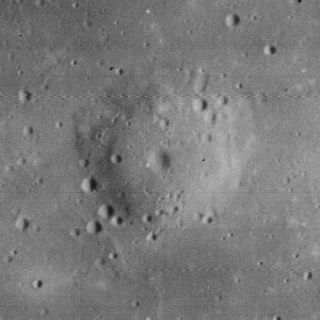 W
WA lunar dome is a type of shield volcano that is found on the surface of the Earth's Moon. They are typically formed by highly viscous, possibly silica-rich lava, erupting from localized vents followed by relatively slow cooling. Lunar domes are wide, rounded, circular features with a gentle slope rising in elevation a few hundred meters to the midpoint. They are typically 8–12 km in diameter, but can be up to 20 km across. Some of the domes contain a small craterlet at the peak.
 W
WThe Fra Mauro formation is a formation on the near side of Earth's Moon that served as the landing site for the American Apollo 14 mission in 1971. It is named after the 80-kilometer-diameter crater Fra Mauro, located within it. The formation, as well as Fra Mauro crater, take their names from a 15th-century Italian monk and mapmaker of the same name. Apollo 13 was originally scheduled to land in the Fra Mauro highlands, but was unable due to an in-flight technical failure.
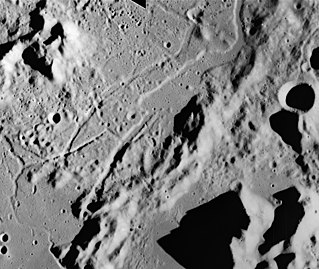 W
WRimae Fresnel is a 90km-long arcuate escarpment on the Moon at 28.0°N 4.0°E. Both the escarpment and the nearby Promontorium Fresnel were named after the French physicist Augustin-Jean Fresnel.
 W
WThe Helmet is an informal term for a highland mass within southern Oceanus Procellarum on the near side of the Moon, southeast of the crater Herigonius. The astronauts of Apollo 16 used the term to refer to the feature during the mission. The name derives from the roughly semicircular shape of the border of the feature, resembling a helmet. The feature is topographically higher and of a higher albedo than the surrounding mare lava plain.
 W
WHyginus is a small lunar caldera located at the east end of the Sinus Medii. It was named after ancient Roman astronomer Gaius Julius Hyginus. Its rim is split by a long, linear rille Rima Hyginus that branches to the northwest and to the east-southeast for a total length of 220 kilometers. The crater is deeper than the rille, and lies at the bend where they intersect. Together the crater Hyginus and Rima Hyginus form a distinctive and prominent feature in an otherwise flat surface. Smaller craterlets can also be discerned along the length of this rille, possibly caused by a collapse of an underlying structure.
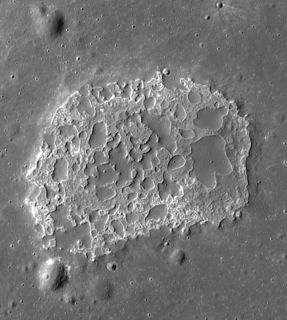 W
WIna is a peculiar small depression on the Moon, in Lacus Felicitatis. It is D-shaped, 2.9×1.9 km wide and 64 m deep.
 W
WLunar lava tubes are tunnels on the Moon that are thought to have formed during basaltic lava flows. When the surface of a lava tube cools, it forms a hardened lid that channels the lava as it continues to flow beneath the surface in a conduit-shaped passage. Once the flow of lava diminishes, the tunnel may drain, forming a hollow void. Lunar lava tubes are formed on sloped surfaces that range in angle from 0.4° to 6.5°. These tubes may be as wide as 500 metres (1,600 ft) before they become unstable against gravitational collapse. However, stable tubes may still be disrupted by seismic events or meteoroid bombardment.
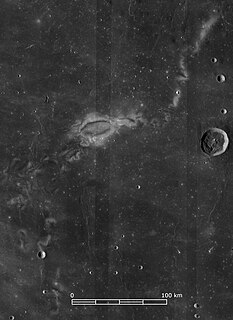 W
WLunar swirls are enigmatic features found across the Moon's surface, which are characterized by having a high albedo, appearing optically immature, and (often) having a sinuous shape. Their curvilinear shape is often accentuated by low albedo regions that wind between the bright swirls. They appear to overlay the lunar surface, superposed on top of craters and ejecta deposits, but impart no observable topography. Swirls have been identified on the lunar maria and highlands - they are not associated with a specific lithologic composition. Swirls on the maria are characterized by strong albedo contrasts and complex, sinuous morphology, whereas those on highland terrain appear less prominent and exhibit simpler shapes, such as single loops or diffuse bright spots.
 W
WThe Marius Hills are a set of volcanic domes located in Oceanus Procellarum on Earth's Moon. The domes are thought to have formed from lavas fairly more viscous than those that formed lunar mares. These domes average approximately 200–500 m (660–1,640 ft) in height. The Marius Hills take their name from the nearby 41 km (25 mi) diameter crater Marius. These hills represent the highest concentration of volcanic features on the Moon.
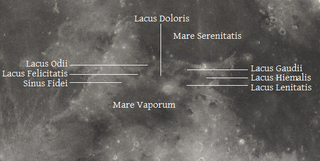 W
WTerra Nivium is a roughly triangular highland region on the Moon. In his Almagestum novum, the notable selenographer Giovanni Riccioli named the various highland regions terrae. However, unlike his naming scheme for craters and lunar maria, his nomenclature for the continental areas of the Moon never came into common use.
 W
WPlanitia Descensus was named to commemorate the site of the first soft landing on the Moon of Luna 9 on 3 February 1966. It is located at Lat. 7.1°N and Long. 64.4W. It is the only officially named plain on the Moon. The Working Group of Commission 17 of the IAU confirmed the name of the site in 1970.
 W
WReiner Gamma (γ) is a geographical feature of the Moon known as a lunar swirl. It is one of the most visible lunar swirls from Earth, visible from most telescopes. It was originally thought to be a lunar highland, but scientists eventually realized that it cast no shadow on the moon.
 W
WRille is typically used to describe any of the long, narrow depressions in the surface of the Moon that resemble channels. The Latin term is rima, plural rimae. Typically a rille can be up to several kilometers wide and hundreds of kilometers in length. However, the term has also been used loosely to describe similar structures on a number of planets in the Solar System, including Mars, Venus, and on a number of moons. All bear a structural resemblance to each other.
 W
WRima Brayley is a sinuous rille on the moon, centered on selenographic coordinates 22.3°N 36.35°W. It crosses from Oceanus Procellarum in the west, passes close to the north rim of Brayley crater, and passes into Mare Imbrium in the east. The name of the feature was approved by the IAU in 1985.
 W
WRima Sharp is a sinuous rille on the moon, centered on selenographic coordinates 46.02°N 50.36°W. The name of the feature was approved by the IAU in 1964. It is named after the nearby crater Sharp.
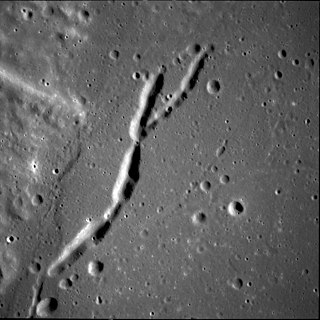 W
WRimae Secchi is a system of rilles on the Moon, in northwestern Mare Fecunditatis. They are approximately 40 km long and run along the shore of the mare.
 W
WThe South Pole–Aitken basin is an immense impact crater on the far side of the Moon. At roughly 2,500 km (1,600 mi) in diameter and between 6.2 to 8.2 km deep, it is one of the largest known impact craters in the Solar System. It is the largest, oldest, and deepest basin recognized on the Moon. It was named for two features on opposite sides of the basin: the crater Aitken on the northern end and the lunar south pole at the other end. The outer rim of this basin can be seen from Earth as a huge mountain chain located on the Moon's southern limb, sometimes informally called "Leibnitz mountains".
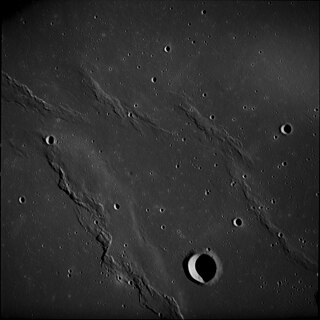 W
WA wrinkle ridge is a type of feature commonly found on lunar maria. These features are low, sinuous ridges formed on the mare surface that can extend for up to several hundred kilometers. Wrinkle ridges are tectonic features created when the basaltic lava cooled and contracted. They frequently outline ring structures buried within the mare, follow circular patterns outlining the mare, or intersect protruding peaks. They are sometimes called veins due to their resemblance to the veins that protrude from beneath the skin.